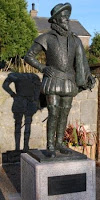A rallying call
 I'm writing to you, dear Sir Walter,
I'm writing to you, dear Sir Walter,Poet, scholar, soldier, courtier,
Trying my best to write in verse
Although you’ll think it must be worse
Than any lines you wrote to please the Queen;
Nay, worse than any you have ever seen.
I write to you from Salterton,
That place where you had lots of fun
Beside the sea four centuries ago,
And where the view down on the beach
Goes further than the eye can reach,
To blood-red sunsets, distant lands of fame,
Of plants and beasts and such wild things and ships
As we can only dream of. Yet your name
For many people stands for nothing more
Than bikes, roll-ups, and naturally chips.
And Budleigh, with its pebbles known as buns,
Down where that naughty lively river Otter runs
Into the sea, is, so many say,
A town of wealthy pensioners, nothing more,
“Famed for its elderly population” reads Wikipedia, for
Long ago that ‘witty’ playwright Noel Coward
Described it as a place of potted palms and monumental bores
Who live life on the golf course, and of course that soured
The reputation of the place
And damage to our tourism did cause.
Yet thanks to Mr Millais and his painter’s easel
You’ll say, I hope, that Coward was a weasel
Who’d never seen that masterpiece
In oils which captures so exactly children’s dreams,
Where your and Master Gilbert’s portrait seems
To say that life on Budleigh beach beside the wall
Is pure and innocent and full of fine belief
Such as they say Man had before the Fall,
Before he twists and turns and prostitutes himself
In search of happiness which often turns to grief.
For so you found, that London town, antithesis of Devon,
Cut short your age of innocence, seduced you out of Heaven.
A life of intrigue, war and politics
Took you from walks beside the Otter
To face the spite of Jacobean rotter
James the First, the Scottish king who coward-like
In fear of Spain agreed to see you dead.
While you with brave advice to “Strike man, strike!”
Lay willing victim on the block
Before you lost your head.
So please Sir Walter, if you’re there
And by some chance you hear my prayer,
Do look at this iconic spot.
Go see the state of Budleigh’s wall.
It isn’t very grand at all.
There is a small blue plastic plaque.
But couldn’t there be something better?
And when I saw the lack
Of screws attaching it
I thought I simply had to write this letter.
© Michael Downes 2009
Sir Walter Raleigh (1552-1618), born only a few miles away at Hayes Barton outside East Budleigh, is one of Devon's heroes. A dashing and handsome military and naval commander he became one of Queen Elizabeth I's favourites at the English court, but was executed on the orders of her successor King James I. He is credited with introducing tobacco and potatoes to Britain and most US readers will know that his explorations led to the colonisation of America, including the founding of the settlement of Virginia, named after his 'Virgin Queen'.
The fine bronze statue of Raleigh, above, was unveiled by the Duke of Kent in 2006.
 This is the famous painting The Boyhood of Raleigh completed by Millais following his stay in Budleigh Salterton in 1870 and now in the Tate Britain collection in London. It shows the young Raleigh on the left and his half-brother Humphrey Gilbert listening, according to the Tate Britain notes, "with rapt attention to the tales of wonders on sea and land told by a sunburnt, stalwart Genoese sailor." Millais is clearly showing us a national hero in the making. The toy ship in the lower left of the painting suggests his future maritime adventures. The painting was exhibited at Budleigh’s Fairlynch Museum a few years ago, on loan from Tate Britain.
This is the famous painting The Boyhood of Raleigh completed by Millais following his stay in Budleigh Salterton in 1870 and now in the Tate Britain collection in London. It shows the young Raleigh on the left and his half-brother Humphrey Gilbert listening, according to the Tate Britain notes, "with rapt attention to the tales of wonders on sea and land told by a sunburnt, stalwart Genoese sailor." Millais is clearly showing us a national hero in the making. The toy ship in the lower left of the painting suggests his future maritime adventures. The painting was exhibited at Budleigh’s Fairlynch Museum a few years ago, on loan from Tate Britain.
And this is the site of the wall on Budleigh beach which Millais chose as the setting.

Across the road from the Raleigh Wall is the odd-looking eight-sided building called the Octagon where Millais stayed.

Here they've done a much better job of marking a special Budleigh landmark.



Comments
Post a Comment